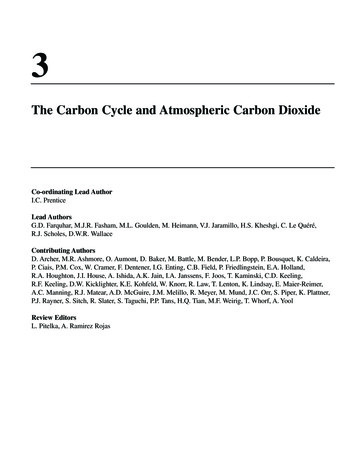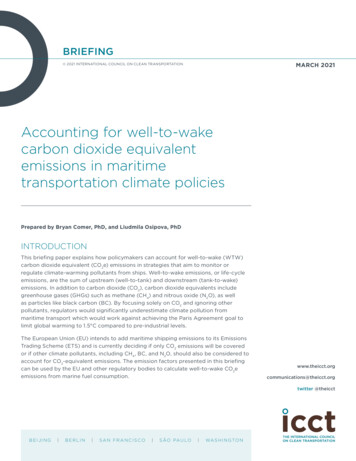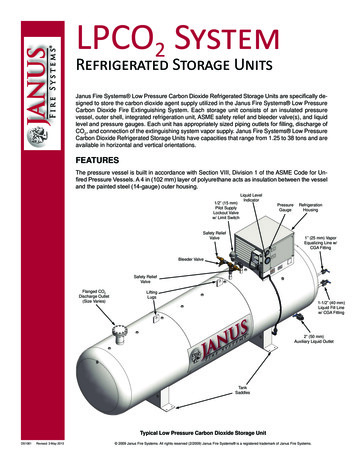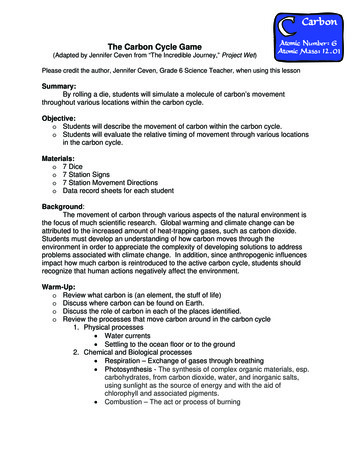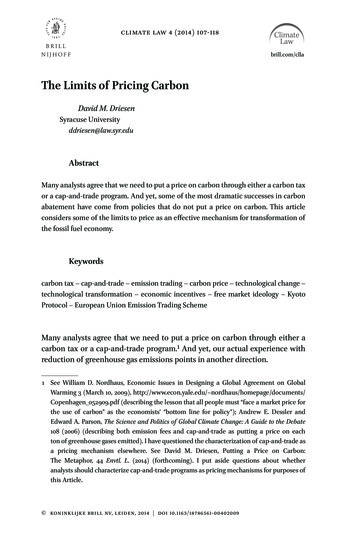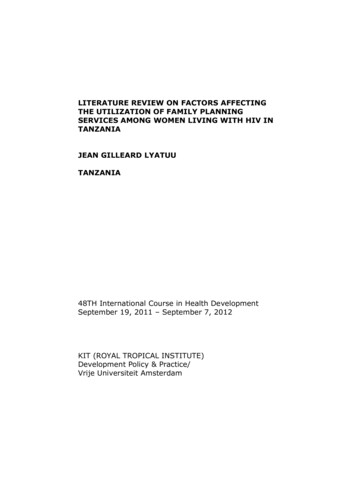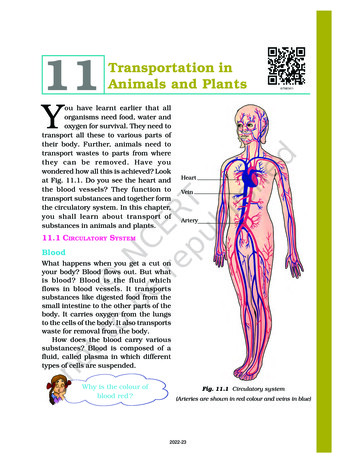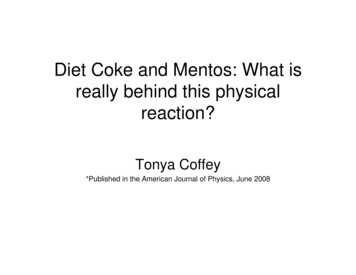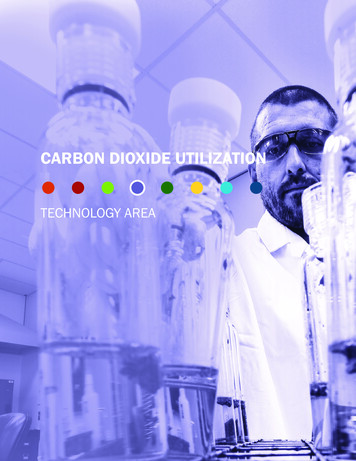
Transcription
2017 PROJECT PEER REVIEWCARBON DIOXIDE UTILIZATIONTECHNOLOGY AREA19Carbon Dioxide Utilization
2019 PROJECT PEER REVIEWCONTENTSINTRODUCTION. 352CO2 UTILIZATION OVERVIEW . 352CO2 UTILIZATION REVIEW PANEL. 353TECHNOLOGY AREA SCORE RESULTS . 354CO2 UTILIZATION REVIEW PANEL SUMMARY REPORT . 355CO2 UTILIZATION PROGRAMMATIC RESPONSE . 358FEASIBILITY STUDY OF UTILIZING ELECTRICITY TO PRODUCE INTERMEDIATES FROM CO2 ANDBIOMASS. 360CO2 UTILIZATION: THERMOCATALYTIC AND ELECTROCATALYTIC ROUTES TO FUELS AND CHEMICALS. 363HYBRID ELECTROCATALYTIC AND THERMOCATALYTIC UPGRADING OF CO2 TO FUELS AND C2 CHEMICALS . 366CO2 VALORIZATION VIA REWIRING CARBON METABOLIC NETWORK . 368IMPROVING FORMATE UPGRADING BY CUPRIAVIDUS NECATOR . 371ENHANCING ACETOGEN FORMATE UTILIZATION TO VALUE-ADDED PRODUCTS . 374SYNTHETIC C1 CONDENSATION CYCLE FOR FORMATE-MEDIATED ELECTROSYNTHESIS . 377INTEGRATION OF CO2 ELECTROLYSIS WITH MICROBIAL SYNGAS; UPGRADING TO REWIRE THECARBON ECONOMY. 380NOVEL CELL-FREE ENZYMATIC SYSTEMS FOR CO2 CAPTURE AND UTILIZATION: BIOENERGY-BASEDBIOLOGICAL CARBON CAPTURE AND VALORIZATION (BECC&V) . 383351CARBON DIOXIDE UTILIZATION
2019 PROJECT PEER REVIEWINTRODUCTIONThe Carbon Dioxide (CO2) Utilization Technology Area is one of 14 related technology areas that werereviewed during the 2019 Bioenergy Technologies Office (BETO) Project Peer Review, which took placeMarch 4–7, 2019, at the Hilton Denver City Center in Denver, Colorado. A total of 11 projects were reviewedin the CO2 Utilization session by five external experts from industry, academia, and other governmentagencies.This review addressed a total U.S. Department of Energy (DOE) investment value of approximately 6,590,000 (Fiscal Year [FY] 2016–2019 obligations), which represents approximately 0.8% of the BETOportfolio reviewed during the 2019 Peer Review. During the Project Peer Review meeting, the principalinvestigator (PI) for each project was given 20 to 30 minutes (depending primarily on the funding level) todeliver a presentation and respond to questions from the review panel.Projects were evaluated and scored for their project approach, technical progress and accomplishments,relevance to BETO goals, and future plans. This section of the report contains the results of the Project PeerReview, including full scoring information for each project, summary comments from each reviewer, and anypublic response provided by the PI. Overview information on the CO2 Utilization Area, full scoring results andanalysis, the Review Panel Summary Report, and the Technology Area Programmatic Response are alsoincluded in this section.BETO designated Dr. Ian Rowe as the CO2 Utilization Technology Area Review Lead, with contractor supportfrom Dr. Mark Philbrick (Allegheny Science & Technology). In this capacity, Dr. Rowe was responsible forall aspects of review planning and implementation.CO2 UTILIZATION OVERVIEWThe CO2 Utilization Technology Area addresses research and development (R&D) barriers associated with theconversion of CO2 to fuels and chemicals. To establish this recent addition to the Conversion R&D portfolio,BETO sought to learn from past and ongoing efforts in CO2 utilization across DOE to determine the researcharea that best suits BETO capabilities. Notably, efforts exist within BETO’s Advanced Algal Systemsportfolio, the Office of Fossil Energy, and the Advanced Research Projects Agency–Energy (ARPA–E);BETO communicated closely with individuals in all of these programs when developing its CO2 utilizationstrategy in an effort to avoid duplication and learn from previous results.Traditionally, producing renewable fuels and products relies on biogenic carbon, and this renewable carbonfeedstock has been largely limited to terrestrial plants or algal biomass and associated intermediates. In suchstrategies, plants use solar energy to chemically reduce CO2 into biomass. This feedstock is then collected anddeconstructed into simple intermediates (sugar, syngas, oil, etc.) before being upgraded to fuels and products.In contrast, the majority of this CO2 Utilization R&D portfolio takes an alternative approach and specificallyinvestigates technologies that perform CO2 conversion through non-photosynthetic and abiotic means,substituting electricity for solar energy in powering CO2 reduction. Such pathways generate one-carbon (C1)or two-carbon (C2) products or intermediates that can be further upgraded through biological or catalyticmeans that are quite similar to existing conversion efforts within the BETO portfolio.This CO2 Utilization Technology Area within BETO began in FY 2017; thus, many of the projects discussedbelow are new and focused on determining what the current state of technology is in the field. Projectsgenerally fall within three categories: (1) non-photosynthetic or nonbiological CO2 reduction for generatingintermediates, (2) biological upgrading of CO2-derived intermediates, and 3) enabling analyses to help informR&D and the life cycle implications of products derived from CO2. Given recent trends in renewable energydeployment and carbon capture, utilizing CO2 as a feedstock is a field of research that is poised to grow, andBETO is well suited to investigate such technologies.352CARBON DIOXIDE UTILIZATION
2019 PROJECT PEER REVIEWCO2 UTILIZATION REVIEW PANELThe following external experts served as reviewers for the CO2 Utilization Technology Area during the 2019Project Peer Review.NameAlissa ParkaAffiliationaColumbia UniversityMatt LucasCarbon180Z. Jason RenPrinceton UniversityMatthew KananStanford UniversityIgor BogoradAmyrisLead Reviewer353CARBON DIOXIDE UTILIZATION
2019 PROJECT PEER REVIEWTECHNOLOGY AREA SCORE RESULTSAverage Weighted Scores by ProjectNREL (2.1.0.304): Feasibility Study of Utilizing Electricityto Produce Intermediates from CO2 and Biomass8.6NREL (2.3.2.111): Improving Formate Opgrading byCupriavidus Necator7.7NREL (2.3.2.112): Enhancing Acetogen FormateUtilization to Value-Added Products7.3NREL (5.1.3.101): Integration of CO2 Electrolysis withMicrobial Syngas; Upgrading to Rewire the CarbonEconomy6.9NREL (2.3.2.106): CO2 Valorization Via Rewiring CarbonMetabolic Network6.8NREL (2.3.2.113): Synthetic C1 Condensation Cycle forFormate-Mediated ElectroSynthesis6.6ORNL (2.3.1.317): Hybrid Electro- and Thermo-CatalyticUpgrading of CO2 to Fuels and C2 Chemicals6.6NREL (2.3.1.316): CO2 Utilization: Thermo- and ElectroCatalytic Routes to Fuels and Chemicals6.5NREL (5.1.3.103): Novel Cell-Free Enzymatic Systems forCO2 Capture and Utilization: Bio-Energy BasedBiologically Carbon Capture and Valorization (BeCC&V)5.80Sunsetting2Ongoing35446810NewCARBON DIOXIDE UTILIZATION
2019 PROJECT PEER REVIEWCO2 UTILIZATION REVIEW PANEL SUMMARY REPORTPrepared by the CO2 Review PanelThe CO2 Utilization program is a new endeavor by BETO to explore the opportunities and potential ofconverting carbon dioxide into biofuels, bioproducts, and biopower using non-photosynthetic pathways such aselectrocatalytic, thermocatalytic, biocatalytic, and hybrid approaches. BETO’s recent report, “Rewiring theCarbon Economy: Engineered Carbon Reduction Report,” serves as the foundation and guideline of thisprogram, and the panel agrees with the evaluation that “the CO2 reduction and utilization technologiesdiscussed have significant potential to impact carbon management and provide economic, environmental, andelectric grid stability benefits.”The panel reviewed 9 slide decks and 11 presentations, and panelists conducted extensive Q&A anddiscussions with the PIs, BETO program managers, and other participants. Overall, the panelists wereimpressed by the organization of the program, the diversity of project topics, and some new findings presentedby the groups. There are several areas that can be improved, such as finding synergies among differentapproaches and groups, collaborating with partners outside of national labs, and better utilizing technoeconomic analysis (TEA) and other tools. The panel provides in this report summarized review comments andrecommendations on program development.IMPACTBecause this is a new topic that has an intrinsic nature of high risk, high reward, BETO funding is critical toadvance the state of technology. Once technologies are advanced to higher technology readiness levels (TRLs)and risks are reduced, private sector investments will likely follow suit.All projects are aligned with the BETO goals on carbon rewiring, and different pathways were wellrepresented. All but one team presented in this program were from the National Renewable Energy Laboratory(NREL), which has been leading the efforts in helping BETO develop the carbon rewiring initiative. Manyscientists and managers were involved in providing technical support, performing feasibility studies, anddeveloping programs. The presentations were grouped in three main categories following a first presentationon TEAs. The three groups each focused on electrocatalytic and/or thermocatalytic pathways, biocatalyticpathways (focused on formate), and the BETO biopower annual operating plan (AOP) call, respectively.The panel was impressed by the techno-economic analysis presented by NREL and thinks this project isstrategically and technically important for carbon rewiring research and program development. The project“Feasibility Study of Utilizing Electricity to Produce Intermediates from CO2 and Biomass” provided goodanalysis on state of the art of CO2 valorization and identified challenges and opportunities to guide and supporttechnology development. The panel suggests in the next period the team consider including more sensitivityanalysis and, if possible, benchmarking evaluation metrics for different processes and technologies. However,the panel cautions that the findings should not be used to pick winners and losers. In addition to academicpublications, it will be much more impactful for the tools and findings to be publicly available via a website orother platforms.The projects on electrocatalytic and/or thermocatalytic CO2 conversions were primarily focused onelectrochemical catalysts development. Broadly speaking, the ability to access multi-carbon products throughelectrocatalytic or thermocatalytic CO2 conversion is a key capability that must be advanced to make theseprocesses viable. The focus on accessing multi-carbon targets is therefore relevant at a fundamental level to theBETO goals. The presentations reported on different types of catalyst development, but various challengeswere reported. While C2 products were targets, none of the catalysts have been able to demonstrate efficientconversion toward targeted products, and the conversion efficiency was low. It was not clear whether some ofthe catalysts such as bimetal cocatalysts would have a high impact on electrochemical CO2 reduction. Whilesome projects mentioned the plan of a CO2 electrolyzer and other device development, little results were355CARBON DIOXIDE UTILIZATION
2019 PROJECT PEER REVIEWpresented. The development of efficient reactor systems can be as critical as catalysts, and associatedchallenges including mass transfer and product separation need to be considered in future studies.The projects on biocatalytic pathways include one project focused on developing the clustered, regularlyinterspaced short palindromic repeats-associated protein 9 (CRISPR-Cas9) tools for Clostridium ljungdahlii todirectly convert CO2/carbon monoxide (CO)/hydrogen (H2) to 3-hydroxybutyrate (3HB). The CRISPR tooldevelopment can be very impactful, as such capacity is critical to enable targeted product generation fromCO2. Three other projects were funded via a formate AOP to convert a key CO2 reduction intermediate formateto higher-carbon products. This includes using Cupriavidus necator to produce polymer precursor βketoadipate, using Escherichia coli to produce glycolate, and using Clostridium ljungdahlii to produce butanol.All these projects were just started with little data presentation. All the projects recognized the value offormate valorization using biological pathways because they can be complementary to the upstreamelectrochemical pathways, which can be highly efficient in converting CO2 to formate. However, commonareas that need improvement include better rationales and quantitative analyses why the proposed pathwaymakes sense in both technological and economic means. The project must also consider the potential marketsand commercialization pathways for these chemicals.The last group of projects were funded by the BETO biopower AOP, which focused on converting wastecarbon into biopower. All projects were required to have industry partners, which the panel thinks is a verygood approach. The projects spanned from CO2 electrolysis with syngas fermentation to biogas upgrade, andto enzyme-accelerated solvents for waste gas scrubbing. While the panelists think that these projects may havepotential in niche applications, a common concern is that the novelty of these projects is not clear. Much of theproposed work seems to have been carried out previously by industrial partners or other entities that thenational lab team attempted to replicate to fit into the AOP scope. In addition, partially because of the earlystage of these projects, it was difficult to evaluate the economic viability of these pathways. TEA and life cycleassessment (LCA) could be very beneficial.INNOVATIONCO2 utilization is a new program, and many of the funded projects were recently started without much datagenerated. However, the panel feels many projects presented innovative ideas and feasible research plans. TheTEA project was ranked highly because it showed very interesting data and could provide critical insights intechnology development, which may avoid unnecessary efforts and provide guidance on addressing criticalbarriers. The CRISPR-Cas9 tool development project also received positive feedback, as it can become apowerful in-house capacity to not only develop engineered Clostridium ljungdahlii strains but also otherbacterial strains that are capable of producing targeted compounds that have never been accomplished before.The development of novel electrochemical catalysts with high conversion efficiency and selectivity can be amajor milestone for CO2 utilization, so even though the projects have not demonstrated success, furtherinvestigations will be critical.SYNERGIESSo far, most projects have a focus on individual areas of CO2 utilization such as catalyst development, straindevelopment, and process engineering. However, there exist significant synergies among the groups withdifferent expertise. The panel highly suggests BETO and researchers explore interdisciplinary collaborations.For example, chemists and material scientists could work together to develop more efficient catalysts for CO2reduction; microbiologists could collaborate with electrochemists to develop high-performing conversionsystems; and scientists and engineers could work jointly to tackle major barriers such as mass transfer, systemintegration, and product separation.Another synergy that should be explored is the collaboration between national lab scientists with universityresearchers and industry partners. Many university groups have been highly productive in CO2 valorizationR&D and increasing numbers of companies have demonstrated success in CO2 utilization as well. Such356CARBON DIOXIDE UTILIZATION
2019 PROJECT PEER REVIEWcollaboration will greatly accelerate the advancement of CO2 research as well as facilitate the development andexpansion of BETO’s carbon rewiring program.FOCUSOverall the CO2 utilization program is well organized, and the portfolio contains diverse and complementaryprojects that covered most conversion pathways. The panel suggests BETO investigate several focus areas thathave not been funded.The program should consider funding projects that investigate hybrid CO2 utilization approaches. As discussedin BETO’s report, a hybrid approach maybe the most efficient way to realize practical CO2 utilization withrenewable electrons, as it combines the efficient abiotic CO2 reduction to intermediates (H2, syngas, formate,methanol, etc.) followed by biological upgrade of the intermediates to high-value, long-chain products.Thermodynamically, the potential losses can be reduced by focusing on desired intermediate production in aCO2 electrolyzer and overcoming surface area limitation in the bioreactor; kinetically, multiphase masstransfer can be increased by designing efficient gas production and delivery system in bioreactor;economically, high-purity and high-titer chemicals can be produced by taking advantage of the metabolicengineering tools; and engineeringly, scaleup systems can be relatively easily developed by modulating eachunit and streamlining production.The program could also consider funding projects that address gas solubility issues, mass transfer limitations,product separation, and issues in system development and integration. These are critical barriers in CO2utilization development, and the understanding and advancement of these topics will help steer the direction offundamental science related to BETO goals, and they will help identify major technological and economicbarriers that maybe overlooked by TEA.The early TEA study presented a great opportunity to provide early intervention help for projects strugglingwith value proposition. Similar work can be supported for LCA as well, because some pathways seem toconsume large amounts of energy, chemicals, materials, and water, and generate a significant amount of waste.The environmental benefits will be important to evaluate, considering these conversion processes are largelycarbon neutral, yet the life cycle may pose negative environmental impacts.TECHNOLOGY DEVELOPMENT PIPELINEGiven that the majority of the projects are still at low TRLs, it is reasonable for BETO to keep investing indifferent pathways until they become mature for early technology adoption by industry. The biopower AOPwas a good approach that required collaboration between national labs and industry partners, but moreguidance and clear expectations could be helpful to identify appropriate project objectives and deliverables.More applied projects on process and reactor development may be valuable to facilitate n 1: The panel recommends that all projects conduct carbon and energy efficiencycalculations as well as TEA, and, if possible, LCA. Such quantitative analysis should be done at the beginning,middle, and end of the project, because it can provide important insights in project development directions,identify critical barriers, and find new opportunities. The panel would recommend TEA-guided milestones andmeasurable deliverables for project management. The panel also cautions that sensitivity analysis should beincluded in TEAs, since most of the time assumptions were made to serve rather than check the project goals.Recommendation 2: The panel supports establishing standardized matrices for project evaluation. Standardparameters may include carbon efficiency, energy efficiency, normalized cost, product titer, selectivity,scalability, etc. The calculation methods should be accessible to the public so the project results can beevaluated by using standardized methods. An open-source user interface and data platform will be helpful toachieve such a goal.357CARBON DIOXIDE UTILIZATION
2019 PROJECT PEER REVIEWRecommendation 3: Interdisciplinary collaborations and applied research need to be encouraged andfacilitated. Such partnerships will accelerate the translation of science understanding into technology andbusiness development. Success measurements need to include both scientific publications and otheraccomplishments such as patent filings, technology licenses, and entrepreneurship.CO2 UTILIZATION PROGRAMMATIC RESPONSEINTRODUCTION/OVERVIEWThe Conversion R&D program would like to thank the entire CO2 Utilization Panel for their hard work andhelpful discussion related to this emerging research area within BETO. As the above summary points out, thepanel found the organization of this new program and the variety of projects within it to be commendable andaligned with BETO goals. The technology balance between biological and catalytic options was seen as wellbalanced. Specifically, the panel found the TEA associated with the “Feasibility Study” to be especiallyimportant for the strategic development of this program specifically as well as the broad field of CO2utilization.The reviewers pointed out the synergistic opportunity for combining researchers that work on catalystdevelopment with their counterparts that are engaged in process engineering and biological straindevelopment. Such interdisciplinary collaboration was seen as key to developing robust conversion systems.Similarly, additional collaboration between those at the national labs and their university and industrialcounterparts could be leveraged to overcome major barriers in CO2 utilization.The panel pointed toward opportunities in funding projects that integrate hybrid approaches to realize practicalCO2 conversion. This can allow catalysis researchers to specify their output stream for the proper engineeringof the relevant bioreactors. Other opportunities in addressing mass transfer limitations, separations, and systemintegration were mentioned as items BETO should be considering.The following section specifically addresses the three major recommendations from the review panel.Recommendation 1: All projects are recommended to conduct carbon- and energyefficiency calculations as well as TEA, and, if possible, LCA.The program agrees with the importance of these assessments. The LCA of any product made from CO2 isextremely important. We currently have an analysis project that broadly looks at the carbon footprint ofvarious pathways related to CO2 utilization. While we absolutely agree that initial LCAs should be consideredwhen thinking about the portfolio, it is still quite early in the process for many of these technologies to divevery deeply into specific pathways; however, we are considering having projects explicitly point out whatmetrics would be needed to hit relevant TEA or LCA values.Recommendation 2: The panel supports the establishment of standardized matrices forproject evaluation.The program wholeheartedly agrees with the importance of such assessments and metrics and this has been apoint of regular discussion. The program is actively considering the specific metrics outlined by the panel aspossible metrics for further work. One opportunity we are examining to get uniformity across the portfolio is toleverage the “Feasibility Study” as well as recent TEA/LCA guidelines from the National Energy TechnologyLibrary and The Global CO2 Initiative.358CARBON DIOXIDE UTILIZATION
2019 PROJECT PEER REVIEWRecommendation 3: Interdisciplinary collaborations and applied research need to beencouraged and facilitated.BETO agrees with the importance of this integration. Of note is the FY 2018 BETO Funding OpportunityAnnouncement, which included a topic area titled “Rewiring Carbon Utilization” that specifically soughtto connect catalytic experts and biologists to ensure that they are developing technologies thatcomplement one another. This resulted in three awards that connected electrochemists and biologists. Theprojects did not begin in time to be presented to the review panel; however, they have since commenced.In general, this specific recommendation is well received and BETO considers the connection ofinterdisciplinary efforts to be essential to advancing CO2 conversion technologies.359CARBON DIOXIDE UTILIZATION
2019 PROJECT PEER REVIEWFEASIBILITY STUDY OF UTILIZING ELECTRICITY TO PRODUCEINTERMEDIATES FROM CO2 AND BIOMASSNational Renewable Energy LaboratoryPROJECT DESCRIPTIONThe primary objective of this project is to assess thetechnical and economic feasibility of utilizing electricityfor (1) the reduction of CO2 to C1–C3 intermediates and(2) the generation and upgrading of biomass-derivedintermediates. Through critical literature review, subjectmatter expert interviews, collaboration with experimentalprojects, and both high-level comparative and detailedTEA coupled with biorefinery integration, this project willdevelop a roadmap for the effective utilization ofelectricity within existing and emerging biorefinerydesigns that can guide ongoing R&D activities towardscost reductions and carbon energy rincipal Investigator:Dr. Josh SchaidlePeriod ofPerformance:10/1/2017–9/30/2020Total DOE Funding: 800,000DOE Funding FY16: 0DOE Funding FY17: 0DOE Funding FY18: 400,000DOE Funding FY19: 400,000Project Status:OngoingWeighted Project Score: 8.6Weighting for Ongoing Projects: Approach - 25%; Accomplishments and Progress - 25%; Relevance - 25%; Future Work - 25%AverageScoreOne standard deviation of reviewers’ scores360CARBON DIOXIDE UTILIZATION
2019 PROJECT PEER REVIEWPhoto courtesy of National Renewable Energy LaboratoryOVERALL IMPRESSIONS This is an important study that can set the important logical pathway toward the future technologicaldevelopment for CO2 utilization. The team has developed a good platform to analyze different pathwaysto identify their challenges and opportunities. This project can be expanded to provide a betterassessment platform for a broader user group. This project is timely and strategically important. The performers did a very good job organizing theproject and delivering critical findings. The findings will be very valuable in understanding thechallenges and opportunities in carbon rewiring R&D. Quantitative metrics will be desired forstandardized evaluation. Uncertainty analysis and mitigation strategies will be helpful when makingassumptions. This project evaluates the technical and economic feasibility of using CO2 or biomass feedstocks andcreating C1–C3 chemicals from them. This work could help identify targets for R&D. The project provides essential analysis to underpin BETO's goal of employing CO2 utilization toimprove the economic competitiveness of biofuels. The team has identified the critical success factors.Further depth on some of the technical issues will be necessary to clarify the research challenges.361CARBON DIOXIDE UTILIZATION
2019 PROJECT PEER REVIEW The performers have proposed to do an in-depth analysis of various technologies to upgrade CO2,including electrochemical, thermochemical, and biological. The performers are covering a very widespace with many built-in assumptions to what the current state of technology is and potential for futureimprovements. During the presentation, the performers focused on electrochemical, which appears to bemost in line with their expertise. The performers are encouraged to narrow the scope of their study to justelectrochemical upgrading, which is already a challenging endeavor. Extending the analysis to biologicalupgrading may lose focus for the study and would be extremely challenging. For example, manypotential bioproducts could be made such as n-butanol, fatty acids, ketoadipate, polyhydroxybutyrate,etc. Publishing their results early on would be very helpful for the other BETO teams, who also will beperforming their own TEA on each project.RECIPIENT RESPONSE TO REVIEWER COMMENTS We greatly appreciate the thoughtful analysis and constructive feedback provided by the reviewers. Wehave sought to assess the technical and economic feasibility of utilizing electricity to reduce CO2 intoC1–C3 intermediates, with the end goal of providing guidance to the R&D community. To that end, weagree with the reviewers that further depth is needed in specific technical areas and that the results needto be broadly disseminated through peer-reviewed publications; we are working diligently to addressthese comments. While we acknowledge that the scope of the study is fairly broad (spanning across fivedifferent direct and indirect CO2 reduction technologies), we believe that the cross-cutting nature of thisanalysis is critical to its value creation for the research community. Due to the time allocated to the peerreview presentation, we decided to use electrochemical conversion as an example case; we have similardetailed studies and cost analyses for all five reduction technologies. Since the start of this project, wehave engaged with subject matter experts across these included technologies, and our project teammembers have diverse technical backgrounds. In o
Utilization program is a new endeavor by BETO to explore the opportunities and potential of converting carbon dioxide into biofuels, bioproducts, and biopower using non-photosynthetic pathways such as . The three groups each focused on electrocatalytic and/or thermocatalytic pathways, biocatalytic pathways (focused on formate), and the BETO .

